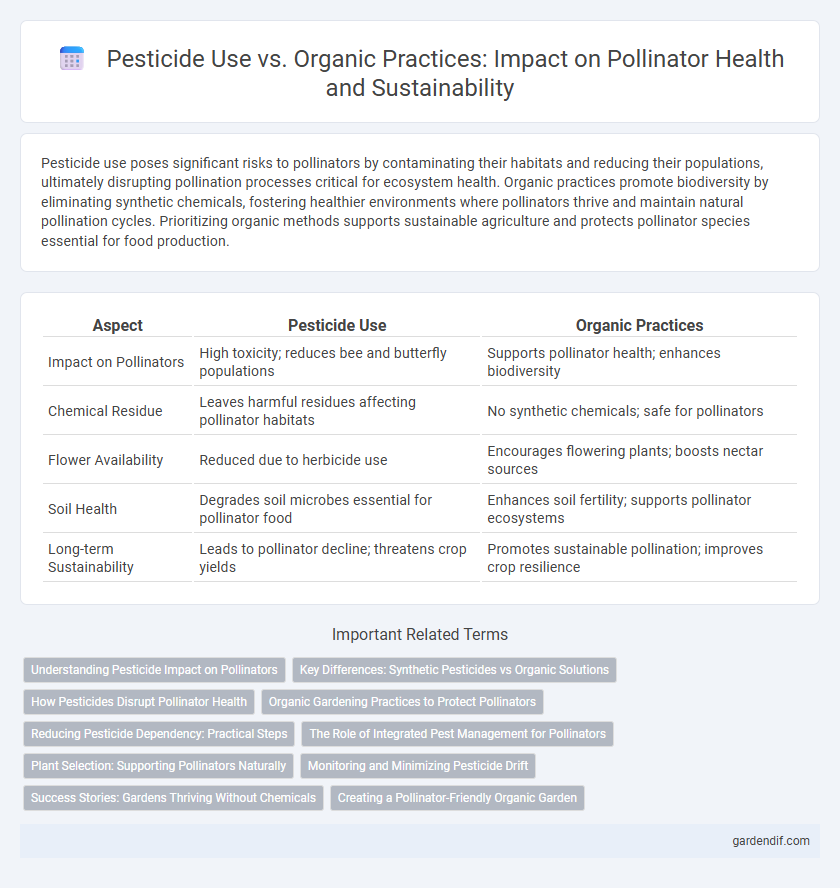
Pesticide Use vs Organic Practices Illustration
Pesticide use poses significant risks to pollinators by contaminating their habitats and reducing their populations, ultimately disrupting pollination processes critical for ecosystem health. Organic practices promote biodiversity by eliminating synthetic chemicals, fostering healthier environments where pollinators thrive and maintain natural pollination cycles. Prioritizing organic methods supports sustainable agriculture and protects pollinator species essential for food production.
Table of Comparison
| Aspect | Pesticide Use | Organic Practices |
|---|---|---|
| Impact on Pollinators | High toxicity; reduces bee and butterfly populations | Supports pollinator health; enhances biodiversity |
| Chemical Residue | Leaves harmful residues affecting pollinator habitats | No synthetic chemicals; safe for pollinators |
| Flower Availability | Reduced due to herbicide use | Encourages flowering plants; boosts nectar sources |
| Soil Health | Degrades soil microbes essential for pollinator food | Enhances soil fertility; supports pollinator ecosystems |
| Long-term Sustainability | Leads to pollinator decline; threatens crop yields | Promotes sustainable pollination; improves crop resilience |
Understanding Pesticide Impact on Pollinators
Pesticide use significantly threatens pollinator populations by contaminating nectar and pollen, leading to impaired navigation, reduced foraging efficiency, and increased mortality. Organic practices minimize harmful chemical exposure, promoting healthier habitats that support diverse pollinator species and enhance ecosystem resilience. Research indicates that reducing synthetic pesticide application correlates with higher pollinator abundance and improved pollination services essential for agricultural productivity.
Key Differences: Synthetic Pesticides vs Organic Solutions
Synthetic pesticides contain chemical compounds specifically designed to eliminate pests but often pose significant risks to pollinators through toxicity and habitat disruption. Organic solutions rely on natural substances and ecological methods that promote pollinator health by preserving biodiversity and minimizing harmful residues. The key difference lies in the balance between effective pest control and the protection of pollinator populations essential for ecosystem stability.
How Pesticides Disrupt Pollinator Health
Pesticide use significantly disrupts pollinator health by causing neurological damage, reducing reproduction rates, and weakening immune systems in bee populations. Studies reveal that neonicotinoids impair foraging behavior and navigation in honeybees, leading to colony collapse disorder. Organic practices mitigate these risks by eliminating synthetic chemicals, fostering healthier habitats that support biodiversity and sustained pollination services.
Organic Gardening Practices to Protect Pollinators
Organic gardening practices eliminate synthetic pesticides and herbicides, reducing toxic exposure that threatens pollinators like bees and butterflies. Techniques such as companion planting, crop rotation, and natural pest control promote healthier ecosystems and sustain pollinator habitats. Maintaining native plants and providing continuous bloom cycles ensures vital nectar and pollen sources, enhancing pollinator survival and biodiversity.
Reducing Pesticide Dependency: Practical Steps
Reducing pesticide dependency enhances pollinator health by minimizing toxic exposure and promoting biodiversity within ecosystems. Implementing integrated pest management (IPM) techniques, including crop rotation, biological control agents, and habitat diversification, effectively controls pests while safeguarding pollinators. Transitioning to organic practices leverages natural pest resistance and soil health improvement, fostering resilient pollinator populations and sustainable agriculture.
The Role of Integrated Pest Management for Pollinators
Integrated Pest Management (IPM) balances pesticide use and organic practices to protect pollinators by minimizing harmful chemical exposure while effectively controlling pests. IPM strategies incorporate biological controls, crop rotation, and selective pesticide application timed to reduce pollinator contact, enhancing pollinator health and ecosystem stability. Data from agricultural studies reveal that fields using IPM report significantly higher pollinator diversity and abundance compared to conventional pesticide-heavy practices.
Plant Selection: Supporting Pollinators Naturally
Plant selection in organic practices prioritizes native, pollinator-friendly species that provide nectar and pollen throughout the growing season, enhancing habitat quality for bees, butterflies, and other pollinators. In contrast, pesticide use often limits plant diversity due to chemical sensitivities, reducing the availability of safe foraging resources. Organic approaches also emphasize planting diverse floral assemblages to create resilient ecosystems that naturally support pollinator health and biodiversity.
Monitoring and Minimizing Pesticide Drift
Monitoring pesticide drift involves using buffer zones, weather data, and drift-reduction technologies to protect pollinators from toxic exposure. Organic practices eliminate synthetic chemicals, promoting natural pest control methods that preserve pollinator health and biodiversity. Integrated pest management strategies that combine rigorous drift monitoring with organic inputs enhance pollinator habitats and ensure sustainable crop production.
Success Stories: Gardens Thriving Without Chemicals
Gardens employing organic practices report significant increases in pollinator populations, with native bee species flourishing without exposure to harmful pesticides. Success stories from community gardens reveal that diverse plantings and natural pest control methods lead to healthier ecosystems and improved pollination rates. These examples underscore the vital role of chemical-free environments in supporting robust pollinator habitats and sustainable biodiversity.
Creating a Pollinator-Friendly Organic Garden
Organic practices minimize pesticide use, fostering a healthy environment for pollinators like bees, butterflies, and hummingbirds. Planting diverse native flowers and avoiding synthetic chemicals enhance nectar sources and nesting habitats, crucial for sustaining pollinator populations. Establishing a pollinator-friendly organic garden supports biodiversity, improves crop yield, and promotes ecosystem resilience.
Pesticide Use vs Organic Practices Infographic

 gardendif.com
gardendif.com